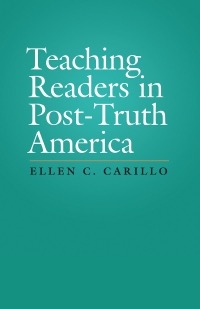teaching reading
Select an item by clicking its checkbox

Teaching Readers in Post-Truth America
Date Reviewed: March 21, 2019
Many teachers have had cause in the last few years to ponder questions around teaching in a “post-truth” culture. How do reading, writing, and thinking change in a world in which groups cannot or will not agree on essential facts and rules of evidence? How can we teach meaningful reading in an overwhelmingly information-rich landscape? How can we heal the divisiveness that pervades so much of our culture, and how can we help students discern true from false? This book is written primarily for instructors in first-year college writing courses, but much of it will prove useful to frustrated teachers in any discipline. It does not give many specific recommendations for classroom strategies, but it does set out thoughtful ideas about how to think about teaching reading.
The book begins with a chapter on “theoretical first principles.” Chapter 2 considers the ways in which standardized tests (and teachers in turn) encourage an unthinking reverence for text by dismissing the role of the reader. Carillo provides convincing evidence of negative outcomes from this approach. These two chapters set the stage for an argument in Chapter 3 about reading and writing as embodied, affective acts, as this writer is firmly against the devaluing of emotion and engagement so common in a world that prizes objectivity. In Chapter 4, Carillo argues that modeling and imitation have been given short shrift in reading instruction. She gives several useful tips for developing imitative exercises that help students see good reading and writing practices, and she especially trumpets the power of annotation, illustrated with a case study from her own teaching. The problems highlighted in Chapter 5, specifically targeting writing and composition instruction, are common to other fields as well: focus on reason over emotion; focus on traditional essay forms; and lack of focus on psychological studies that can enhance both teaching and learning.
This book’s title promises more than it delivers, although it delivers a lot. Carillo’s insistence on redirecting students away from claims and argumentation and “toward stylistic elements that contribute to a text’s meaning” (41) will strike many teachers trained in other modes as difficult to attain. “Reading for argument” is, for Carillo, a problem: students only read for a relatively simplistic argument and miss so much that could make them stronger readers, such as inquiring about the how and why, not just the what. Yet many teachers find that students can’t even read for argument, a fact this book glosses over.
That said, a call to encouraging more affective and empathetic reading is timely and needed. The use of Peter Elbow’s doubting and believing game (47-50) will be familiar to many in religious studies, as will the call to look outside one’s own discipline for expertise. This book helps teachers think about ways to mitigate aspects of culture that revere text and steer students “away from the language of negotiation and compromise” (114).

Reading, Writing, and Discussing at the Graduate Level A Guidebook for International Students
Date Reviewed: January 18, 2016
Reading, Writing, and Discussing at the Graduate Level A Guidebook for International Students by Rina Kim, Lillie R. Ablert, and Hang Gyun Sihn is a new resource for graduate international students and those who work with them in the academic setting. The three authors come from diverse personal and academic backgrounds and draw from their experiences as international students themselves and from working with international students in developing this text. They provide a guidebook for students who are proficient in English but struggle to understand the “academic culture and norms in the United States” (ix).
Each chapter focuses on a different aspect of graduate level work; academic reading, in-class discussions, writing assignments, preparing oral presentations, and developing relationships with classmates and professors. The authors do a good job of stating the limited scope of their effort. They recognize that the text is not going to provide a comprehensive primer on academic writing or research, but they point out common ways in which international students are derailed in their efforts because they misunderstand expectations. Throughout the text, the authors draw on informal conversations they have had with students to illustrate common perspectives or misunderstandings. The scenarios they highlight help to clarify issues and suggest ways of moving forward. These scenarios provide some of the most helpful insights in the book.
International students may find chapter two on “Engaging in Academic Discussions” and chapter five on “Developing Social and Academic Relationships” to be the most helpful because they discuss at length ways to build confidence and helpful hints for anticipating the atmosphere of classroom interactions in the United States. The most effective aspects of each chapter are the ways in which the authors show how perspectives and expectations differ even in basic items such as how reading lists are arranged in a syllabus or clarifying the expectation to write in your own words. The subtle nuances of the academic culture of the United States are dealt with in a relaxed manner, encouraging students to ask questions or seek help when necessary.
The text does assume a high level of reading proficiency. This is stated clearly by the authors, but the writing might be too complex for the students who are seeking the type of assistance the book covers. Although the main audience is the international student, this book is probably more helpful for faculty members who are beginning to teach international students. The informal scenarios that are scattered throughout the book provide a helpful window into the mind of the international student. Faculty members or other mentors will find this text helpful as they shape assignments, engage international students in classroom discussions, and articulate expectations.